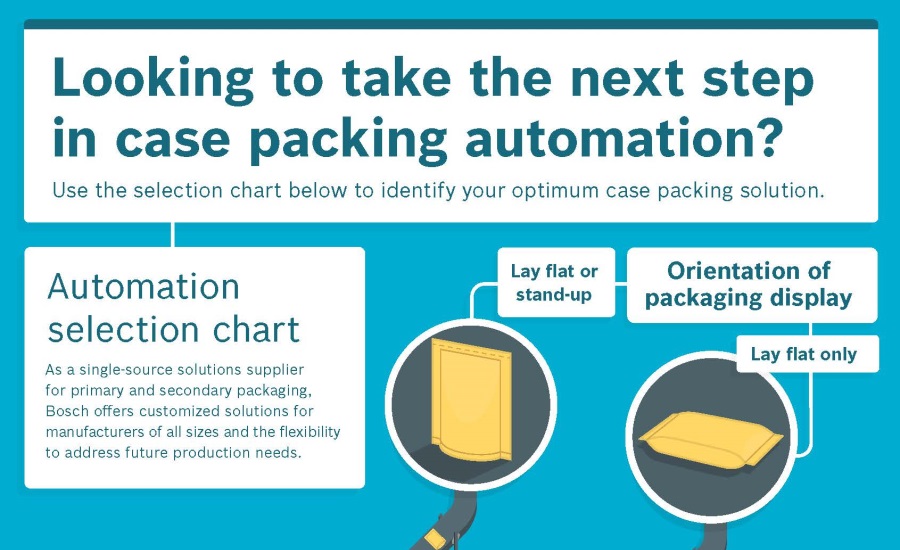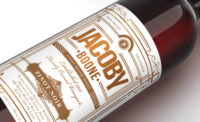Boxing up the competition with the right secondary packaging

Primary packaging is extremely important for product quality protection however, secondary packaging or case packing is of similar meaning when it comes to safeguarding products during transportation and display on the store shelf. We recently sat down with Eric Aasen, product manager at Bosch Packaging Technology (boschpackaging.com) to discuss the expanding role of secondary packaging.
Q: How have manual and automated technologies changed in recent years, are you seeing a shift towards one or the other?
Today’s society features an “on-the-go” economy where consumers want what they want when they want it, and are continuously demanding new products. As a result, manufacturers are changing how they address their processing and packaging needs - shifting away from manual operation and towards fully automated technologies. Automation is beneficial as it enhances product safety, ensuring compliance with regulations and minimizing the risk of recalls. Moreover it increases output due to continuous operation independent of human presence and provides gentle handling for delicate products.
As a result of the automation shift, more manufacturers are turning to single-source solution providers for all of their processing and packaging technology needs as they offer a consolidated approach and extensive knowledge. While it is possible to create complete lines by incorporating technologies from multiple companies, integrating new technologies and synchronizing individual components requires an investment of both time and physical effort, limiting output. Single-source solution providers design their technology to work in harmony with other machines in their portfolio, reducing total cost of ownership (TCO) and the time needed for equipment installations.
Q: How does the incorporation of automated secondary packaging technologies benefit the producers of food, snack and confectionery products?
The timing will always vary according to the specifics of any given operation, but when manufacturers incorporate automated secondary packaging technologies into their processing and packaging lines they will typically see a return on investment within 12 to 18 months. The benefits of automation however, are apparent immediately upon installation with speed and output enhanced. In the longer term, by employing dependable machine technologies, there will also be a noticeable impact on their equipment reliability, which ultimately improves overall operational efficiency (OEE) while reducing human errors.
Food and especially confectionery producers also benefit from enhanced product protection, minimizing waste and the risk of recalls. When selecting the appropriate solution for a product, it is important to focus on its characteristics such as breakability, size and presentation. If the product is particularly robust and it comes in larger bags, then a drop packer might be a sufficient solution whereas for fragile products that need gentle handling, or the capability to handle random flow, the robotic solutions are ideal. From there, decisions need to be made about the size of the bag – medium to large bags are best handled by a two-axis robot, while for smaller bags up to three kilograms manufacturers should choose to work with a Delta robot.
Flexibility is another reason for manufacturers to turn to secondary packaging automation. The solution should not only meet current needs, but also take into consideration demands of tomorrow. For example, what bag styles and secondary packaging orientation will be required? Does it stand-up (such as a block-bottom bag) or does it lie flat (such as a pillow bag)? For stand-up and lay-flat bags, a two-axis robot with case rotation will be a good choice as it allows the bags to be placed gently into a packaging case by rotating the case itself, rather than the bag. For small, lay-flat bags, however, Delta robots are the better option as they offer gentle operation but operate at higher speeds. Case styles needs to be considered as well. For Regular Slotted Containers (RSC), Half-Slotted Containers (HSC) and retail-ready packaging, manufacturers should choose a flexible two-axis robot. There is also the question of the pack pattern – how the products will be packaged into the box. Delta robots, for example, can handle multiple and complex patterns more easily than other technologies as they incorporate multiple axes of motion. In other cases, or for mid- to larger-sized bags a two-axis robot will still be able to offer considerable flexibility of pack pattern.
Along with efficiency and production, it is also important to note that these same technologies can play a wider role in benefitting the company’s workforce. In some cases, these benefits are specific to the industry – for example in the frozen food market, where automated technologies can enable machine operators to be taken out of cold or sub-zero temperature environments and then reallocated to higher-level tasks. At the same time, however, across any industry, utilizing automated packaging equipment can help manufacturers refocus personnel elsewhere, limiting the number of workers on the shop floor and minimizing the risk for worker injury and accidents.
Q: What are some of the latest developments that have been seen with regards to automation in end-of-line packaging?
Case packing solutions must accommodate multiple pack styles and sizes to keep up with continuous innovation in primary packaging. That is something that suppliers like Bosch have been placing a greater emphasis on in recent years.
One example is Bosch’s CCM 3100 flexible case packer – a two-axis robot that is capable of handling multiple pack styles. Two-axis machines are designed to meet specific needs such as high speed for increased output, and reduced footprint for use in facilities with limited floor space. The CCM 3100 has the flexibility to handle all of the commonly-used retail-ready packaging styles, including RSC and HSC. Of particular benefit to manufacturers that specialize in short production runs, the CCM 3100 allows for quick, tool-less changeovers between horizontal (lay flat) and vertical (stand-up) presentation of the products at the point-of-sale. The machine can be combined with vertical form, fill and seal (VFFS) as well as horizontal flow wrapper (HFFS) technologies for a complete solution.
Another area that we are seeing increasing interest is in the field of Delta robots, which are designed to provide in-line automation to handle fragile and random flow products at higher speeds. At the same time, new developments are leading to solutions that are particularly effective in helping food producers lower the TCO of both, their primary and secondary packaging equipment. The D3 Delta robotic platform, which Bosch recently launched, is one such example – representing the newest generation of the GD series. The enhanced D3 robotic platform handles higher payloads of up to three kilograms and ensures faster speeds to increase pick rates. Designed for quick changeovers, simplified use and maintenance, it allows manufacturers to achieve a lower total cost of ownership (TCO) and a shorter return on investment (ROI) period.
Q: What advice can you offer to manufacturers looking to explore automated case packing options?
Identifying the ideal automated case packing or secondary packaging solution can be challenging but manufacturers can simplify the process by selecting the right supplier and distinguishing their unique product packaging needs. When selecting a supplier to work with, it’s crucial to choose a company who offers a full portfolio. A provider of processing, primary and secondary packaging equipment can provide overall expertise in developing a solution tailored to meet production goals. If there is a challenge or service is requested – during installation and integration or beyond – a single-source supplier will be able to address all of those needs, which can accelerate the packaging line start up.
The other piece of advice I would offer is for manufacturers to choose technology that is best suited for their current and future needs. If a customer is concerned with speed and increased output then a two-axis robot is the ideal choice; those looking for a solution that is suitable for in-line automation layout and with the capacity to handle random flow, then a two-arm Delta robot is going to be preferable. Ultimately, by taking their time to review all options, and discussing any specific needs with their supplier, manufacturers will find themselves better equipped to grow their business and maintain the competitive edge.

About the Author
Eric Aasen has been involved in the packaging industry for 28+ years and has served many functions within the Bosch Organization. Eric started his career as an electrical/software engineer, designing equipment and writing software for the Doboy product line, to project management, sales management, product line management for the VFFS product line and most recently is the product manager for all products produced at the Bosch Packaging Technology facility in New Richmond, WI. During his career, Eric has also spent extended durations working for sister companies in Switzerland and California.
Looking for a reprint of this article?
From high-res PDFs to custom plaques, order your copy today!






